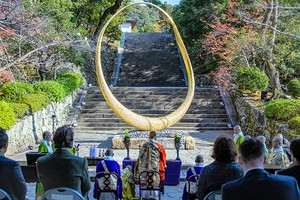By KUNIO OZAWA/ Staff Writer
February 19, 2022 at 07:00 JST
KURASHIKI, Okayama Prefecture—A “mermaid mummy” kept at a temple has been an object of worship, the stuff of nightmares and a source of mystery for hundreds of years.
Now, for the first time, a project has started to scientifically analyze the mummified creature, which has the upper body of a human and the lower body of a fish.
The researchers from the Kurashiki University of Science and the Arts here and other organizations plan to announce their findings around autumn.
On Feb. 2, Kozen Kuida, 60, chief priest at Enjuin temple in Asakuchi in the prefecture, removed the 30-centimeter-long treasured specimen from a paulownia box in the CT scanning room of the university’s veterinary hospital.
Laying face up on an examination table, the mummy appeared to be locked in a scream while holding its hands to its mouth. In addition to nails and teeth, the mummy has hair on its head and scales on the lower body.
According to a note contained in the same box of the “dried mermaid,” the creature was caught in a fishing net on the coast of Tosa Province (present-day Kochi Prefecture) between 1736 and 1741.
The Kojima family in Bingo-Fukuyama Province bought the mummy before it was passed on to other owners after the turn of the Meiji Era (1868-1912).

How Enjuin temple acquired the mummy is also a mystery.
It was put on display in a glass case for public viewing about 40 years ago. But it is now kept in a fireproof safe to prevent deterioration, Kuida said.
Hiroshi Kinoshita, 54, a board member of the Okayama Folklore Society, came up with the project after coming across a photo of the mummy while reading materials left by Kiyoaki Sato (1905-1998), a natural historian from Satosho in the prefecture.
Sato is believed to have written Japan’s first encyclopedia on “yokai” ghouls, hobgoblins and other supernatural creatures of Japanese folklore.
After learning that the mermaid mummy was housed at Enjuin, Kinoshita sounded out officials at the temple and the university to conduct the research, he said.
Mermaid mummies have also been reportedly used as objects of worship at Mount Koyasan in Wakayama Prefecture and on Amami-Oshima island in Kagoshima Prefecture.
According to Kinoshita, one of them has the upper body of a monkey and the lower body of a salmon.
Takafumi Kato, 54, a professor at the university specializing in paleontology, is in charge of the morphology analysis of the upper body of the Enjuin temple specimen. It will be his first research on a mythical creature.
He intends to examine the antiseptic treatment of the well-preserved mummy.
An associate professor specializing in ichthyology is focusing on the lower body, while another associate professor with expertise in molecular biology is carrying out a DNA analysis.
Kinoshita is analyzing the relic from the standpoint of folklore studies.
The Kurashiki Museum of Natural History, which served as an intermediary between Enjuin and the university, is providing support for the project.
Kuida likens the mermaid mummy to Amabie, a folklore monster believed to have the power to fend off plagues.
“We have worshipped it, hoping that it would help alleviate the coronavirus pandemic even if only slightly,” the head priest said. “I hope the research project can leave (scientific) records for future generations.”




















A peek through the music industry’s curtain at the producers who harnessed social media to help their idols go global.
A series based on diplomatic documents declassified by Japan’s Foreign Ministry
Here is a collection of first-hand accounts by “hibakusha” atomic bomb survivors.
Cooking experts, chefs and others involved in the field of food introduce their special recipes intertwined with their paths in life.
A series about Japanese-Americans and their memories of World War II